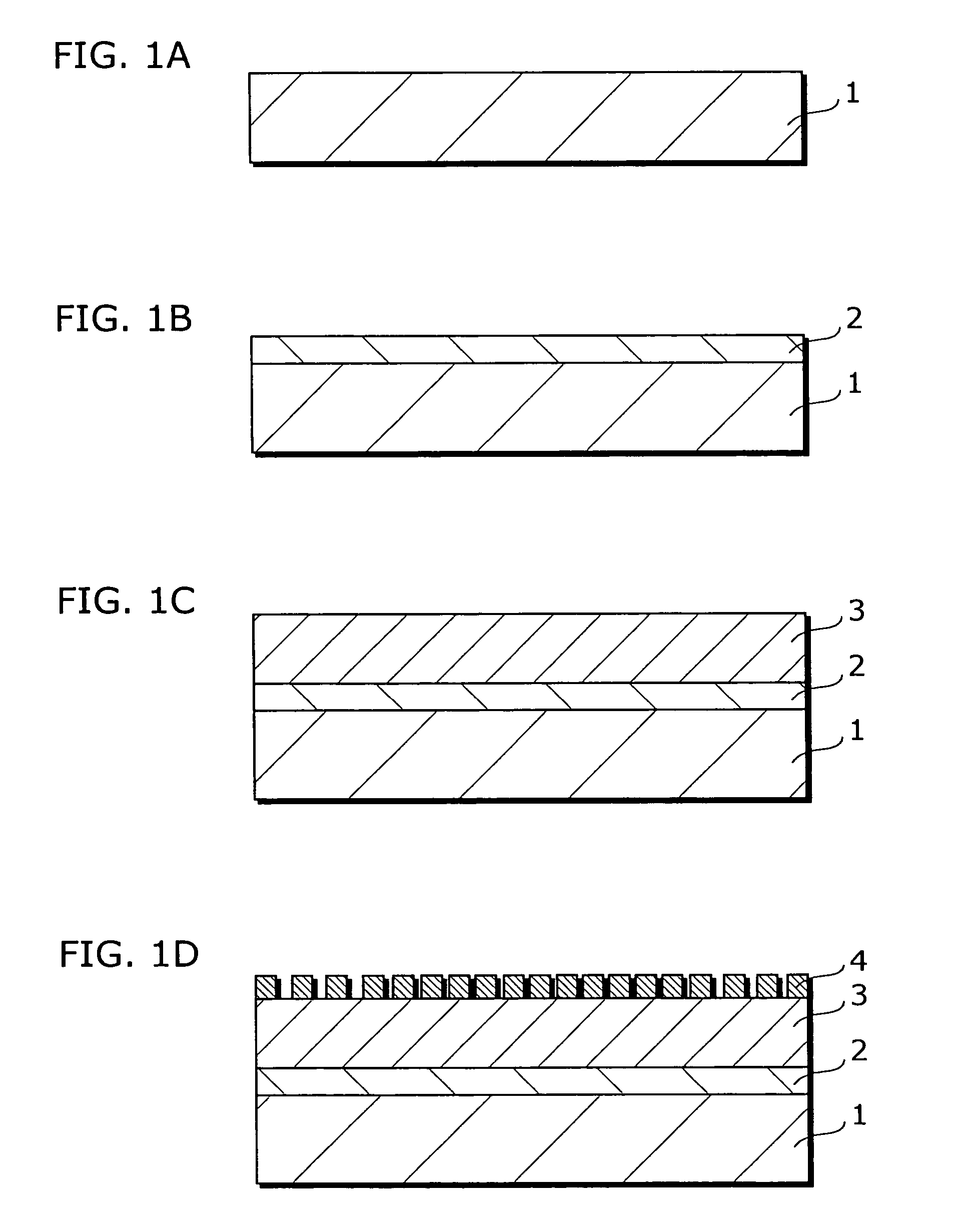Manufacturing method for semiconductor device, semiconductor device and semiconductor wafer
a manufacturing method and semiconductor technology, applied in the direction of crystal growth process, polycrystalline material growth, chemically reactive gas, etc., can solve the problems of reducing light-emitting efficiency, limiting the combination of base and growth layer, and generating cracks on the growth layer. , to achieve the effect of preventing crack generation and high yield
- Summary
- Abstract
- Description
- Claims
- Application Information
AI Technical Summary
Benefits of technology
Problems solved by technology
Method used
Image
Examples
first embodiment
(First Embodiment)
[0042]By referring to FIGS. 1 to 7, a manufacturing method for an ultraviolet emitting LED device 20 (refer to following FIG. 3J) in the first embodiment is explained. Here, FIGS. 1 to 3 show a process of the manufacturing method for the ultraviolet LED device 20 in the present embodiment using cross-section diagrams. A substrate 1 shown in FIG. 1A is a n-type 6HSiC whose diameter is 2 inch.
[0043]Firstly, an AlN layer 2 is formed in 1 μm thick at a high temperature of 1000° C. on the substrate 1 by a Metal Organic Chemical Vapor Deposition (MOCVD) method using trimethyl aluminum as a III group material, ammonia as a V group material, and hydrogen as a carrier gas (FIG. 1B).
[0044]Following that, on the AlN layer 2, a base layer 3 made of n-type Al0.2Ga0.8N is formed in 2 μm thick at a high temperature of 1000° C. (FIG. 1C). Here, AlGaN can be obtained by mixing trimethyl gallium with trimethyl aluminum in an appropriate proportion and growing the mixed. Also, Si, Ge...
second embodiment
(Second Embodiment)
[0097]By referring to FIGS. 8 to 14, a manufacturing method for the ultraviolet LED device 30 (refer to FIG. 10J) in the second embodiment is explained. In the present embodiment, an example which is effective for the crack prevention without forming steps for low defectives in the device region 61 is explained.
[0098]FIG. 8A is a cross-section diagram of the substrate 1.
[0099]On the substrate 1 made of the n-type 6HSiC, the AlN layer 2 is formed to have a thickness of 1 μm by the MOCVD method (FIG. 8B).
[0100]Next, on the AlN layer 2, the base layer 3 made of the n-type Al0.2Ga0.8N is formed to have a thickness of 2 μm (FIG. 8C).
[0101]As shown in FIG. 8D, the masks 4 are formed on the base layer 3 by the photoresist. The mask pattern is patterned to cover all regions except where the trenches 502 are formed and steps are not set intentionally in the device region 61, the trenches 502 being discussed later.
[0102]Further, the trenches 502 are formed by setting the ma...
third embodiment
(Third Embodiment)
[0119]The present embodiment shows an example examined for plane shapes of trenches. Hereafter, a manufacturing method for an ultraviolet LED device 40 (not shown in diagrams) in the present embodiment is explained with reference to FIG. 15 and FIG. 16.
[0120]FIGS. 15 and 16 are diagrams showing shapes of trenches to be examined about shapes of a device region 61, a trench region 64 and a convex region 65. Each trench is formed using the exactly same manufacturing method used in the first embodiment (that is, only the shape of the trench 502 shown in FIG. 2F is changed). The trench region 64 shown in FIGS. 15 and 16 applies to the second trench 502 shown in FIG. 2F. The convex region 65 applies to a non-etched region between adjacent second trenches 502 shown in FIG. 2F.
[0121]FIGS. 15A to 15E show examples of shapes of trenches which are effective to prevent a crack generation, that is, shapes of trenches by which the crack is not generated in the device region 61.
[...
PUM
| Property | Measurement | Unit |
|---|---|---|
| diameter | aaaaa | aaaaa |
| temperature | aaaaa | aaaaa |
| thick | aaaaa | aaaaa |
Abstract
Description
Claims
Application Information
 Login to View More
Login to View More - R&D
- Intellectual Property
- Life Sciences
- Materials
- Tech Scout
- Unparalleled Data Quality
- Higher Quality Content
- 60% Fewer Hallucinations
Browse by: Latest US Patents, China's latest patents, Technical Efficacy Thesaurus, Application Domain, Technology Topic, Popular Technical Reports.
© 2025 PatSnap. All rights reserved.Legal|Privacy policy|Modern Slavery Act Transparency Statement|Sitemap|About US| Contact US: help@patsnap.com



